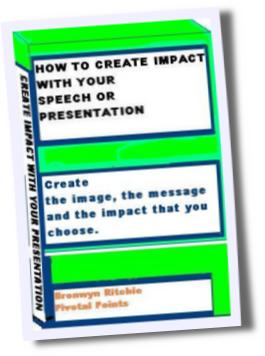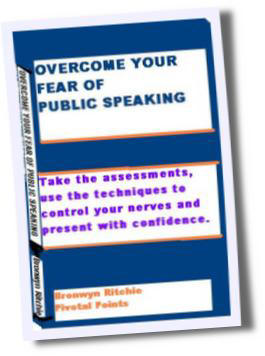Before that, there were chalkboards and before that, well, there were just speakers! And believe it or not, speakers were plenty effective, even without visuals.
There’s no doubt that visuals
provide additional benefits to a
presentation. According to
“Public Speaking: An
Audience-Centered Approach” by
Steven A. Beebe and Susan J.
Beebe, presentation aids
“enhance understanding,”
“enhance memory,” “help
listeners organize ideas,” “help
gain and maintain attention,”
and “help illustrate a sequence
of events or procedures.”
Read on for tips on effective and creative visual aids the low-tech, old-fashioned way.
1. Before the presentation
Flip charts
Write out your flip charts in
advance (unless you’ll be
writing down comments or
questions from the audience).
Leave one or two blank pages in
between your prepared pages, in
case you want to add something
during the presentation. This
also keeps your following pages
from showing through.
Make sure your text is big
enough for everyone in the room
to see – letters should be 2-3”
tall, depending on how big the
room is. Text should be in dark
colors so your audience doesn’t
have to strain to see
it. Using a pad with a grid and
perforations ensures neat
writing and tearing. And
double-check your spelling
before putting away your flip
chart!
I like using the sticky flip
chart paper; it’s like a giant
Post-it® note that I can tear
off and adhere to the wall. The
page can be repositioned as
necessary, and the chart can
stand by itself on a tabletop.
No
need for tape or an easel.
See Garr Reynolds’ resource list of flip chart tips: http://www.presentationzen.com/presentationzen/2007/04/presentations_e.html
Handouts, part 1
Prepare only what is necessary
to recap your main points or
give additional resources, such
as a copy of a magazine article
or a list of websites or books
to use for further research on
your topic.
You may want to include a simple marketing document, such as a brochure, but don’t go overboard with marketing materials – including your name and contact information at the bottom of your handouts should be enough. And keep your documents simple and easy to read; don’t overwhelm your audience with too much reading material.
Print handouts on colored papers to differentiate each one for your audience and to eliminate the monotony of all-white handouts.
Signs, posters or large
images
You may want to give your
audience something to look at as
they are entering the room and
taking their seats. A
poster-size photograph or other
striking image that relates to
your topic is a great visual to
get
everyone on the same page. Just
make sure to cover it or take it
down before you start speaking,
so the audience isn’t distracted
by it.
2. During the presentation
Props
Props can add interest and humor
to your presentation, and help
illustrate your points, as long
as you don’t overuse them and
you practice before your
presentation.
Props can be items put around
the room for audience members to
use or enjoy before or during
the presentation, such as candy,
snacks, puzzles, or toys. These
work best in interactive
workshop settings,
where you are expecting your
audience to be active.
Props can help you remember
certain parts of your
presentation without using
notes, such as an item you pick
up to demonstrate a particular
point. Props, as a visual cue,
also help your audience remember
what you talked about. For
example, one speaker, whose
topic was compulsive shopping,
delivered her handouts to her
audience in mini shopping bags.
Instead of a pie chart, how
about cutting up a real pie? Or
put on several hats to signify
different sections of your
presentation. Props don’t have
to be complicated. Any prop used
well can add a special touch
to your presentation. Make sure
the prop can be seen by everyone
in the room, and don’t bring it
out until you’re ready to use
it.
Demonstration
Is there something related to
your topic that you can
demonstrate as part of your
presentation? Can you make an
origami crane, or do a short
craft project, or demonstrate
how to re-pot a plant?
Demonstration is a great teaching tool if you are clear, concise, and give well-organized instructions.
Handouts, part 2
Save handouts till the end or,
if you need your audience to
follow along on a document, only
hand out the one they need at
the time they need it. Handouts
are distracting and take the
focus off of the speaker, so
plan carefully when you’re going
to give them out.
3. After the presentation
Ideally, you have a table at
the back of the room where you
can display additional handouts,
books, brochures, business
cards, and other resources for
your audience. Make a vertical
display board for this
table that includes photos,
maps, graphs, charts, text, and
other visuals to grab your
audience as they walk in and as
they are leaving the room. This
is a good way to display complex
information that wasn’t
appropriate to go over in detail
during the presentation.
Using a variety of visual techniques helps you grab and keep your audience’s attention, and it helps them retain what they learn. Try something new: visuals don’t have to be high-tech to be high-impact.
|
Lisa Braithwaite
works with
individuals to
uncover their
challenges and build
their strengths in
presenting
themselves
confidently as
speakers. Find your
voice with public
speaking coaching!
Sign up for the
Presentation
Pointers newsletter
or a free
consultation at
http://www.coachlisab.com.
Check out the
Build Skills and
Confidence e-course
and the
Speak Schmeak
blog.
|





